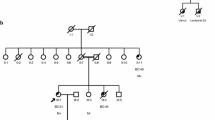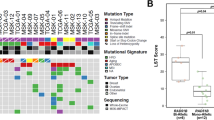Abstract
BRCA1 and BRCA2 are the most well-known breast and ovarian cancer susceptibility genes. Additional genes involved in DNA repair have been identified as predisposing to breast cancer. Recently, RAD51C, a new Fanconi Anemia gene, essential for homologous recombination repair, has been reported to be a rare hereditary breast and ovarian cancer susceptibility gene. Indeed, several pathogenic mutations have been identified in BRCA1/BRCA2-negative hereditary breast and ovarian cancer families. Here, we present the results of the screening of RAD51C mutations in a large series of 516 BRCA1/BRCA2-negative Spanish patients from breast and/or ovarian cancer families, and the evaluation of these results in the context of all RAD51C carriers. RAD51C mutation screening was performed by DNA analysis for all index cases. All the genetic variants identified were analyzed in silico for splicing and protein predictions. cDNA analysis was performed for three selected variants. All previous RAD51C mutation studies on breast and/or ovarian cancer were reviewed. We identified three inactivating RAD51C mutations. Two mutations were found in breast and ovarian cancer families and one mutation in a site-specific breast cancer family. Based on the mean age of ovarian cancer diagnosis in RAD51C carriers, we would recommend prophylactic bilateral salpingo-ophorectomy in premenopausal RAD51C mutation carriers. Our results support that RAD51C is a rare breast and ovarian cancer susceptibility gene and may contribute to a small fraction of families including breast and ovarian cancer cases and families with only breast cancer. Thus, RAD51C testing should be offered to hereditary breast and/or ovarian cancer families without selecting for specific cancer origin.

Similar content being viewed by others
References
Peto J, Collins N, Barfoot R et al (1999) Prevalence of BRCA1 and BRCA2 gene mutations in patients with early-onset breast cancer. J Natl Cancer Inst 91:943–949
Miki Y, Swensen J, Shattuck-Eidens D et al (1994) A strong candidate for the breast and ovarian cancer susceptibility gene BRCA1. Science 266:66–71
Wooster R, Bignell G, Lancaster J et al (1995) Identification of the breast cancer susceptibility gene BRCA2. Nature 378:789–792. doi:10.1038/378789a0
Nichols KE, Malkin D, Garber JE et al (2001) Germ-line p53 mutations predispose to a wide spectrum of early-onset cancers. Cancer Epidemiol Biomark Prev 10:83–87
Pilarski R, Eng C (2004) Will the real Cowden syndrome please stand up (again)? Expanding mutational and clinical spectra of the PTEN hamartoma tumour syndrome. J Med Genet 41:323–326
Meijers-Heijboer H, van den Ouweland A, Klijn J et al (2002) Low-penetrance susceptibility to breast cancer due to CHEK2(*)1100delC in noncarriers of BRCA1 or BRCA2 mutations. Nat Genet 31:55–59. doi:10.1038/ng879
Desrichard A, Bidet Y, Uhrhammer N, Bignon Y-J (2011) CHEK2 contribution to hereditary breast cancer in non-BRCA families. Breast Cancer Res 13:R119. doi:10.1186/bcr3062
Swift M, Reitnauer PJ, Morrell D, Chase CL (1987) Breast and other cancers in families with ataxia-telangiectasia. N Engl J Med 316:1289–1294. doi:10.1056/NEJM198705213162101
Thorstenson YR, Roxas A, Kroiss R et al (2003) Contributions of ATM mutations to familial breast and ovarian cancer. Cancer Res 63:3325–3333
Seal S, Thompson D, Renwick A et al (2006) Truncating mutations in the Fanconi anemia J gene BRIP1 are low-penetrance breast cancer susceptibility alleles. Nat Genet 38:1239–1241. doi:10.1038/ng1902
Rahman N, Seal S, Thompson D et al (2007) PALB2, which encodes a BRCA2-interacting protein, is a breast cancer susceptibility gene. Nat Genet 39:165–167. doi:10.1038/ng1959
Takata M, Sasaki MS, Tachiiri S et al (2001) Chromosome instability and defective recombinational repair in knockout mutants of the five Rad51 paralogs. Mol Cell Biol 21:2858–2866. doi:10.1128/MCB.21.8.2858-2866.2001
Masson JY, Tarsounas MC, Stasiak AZ et al (2001) Identification and purification of two distinct complexes containing the five RAD51 paralogs. Genes Dev 15:3296–3307. doi:10.1101/gad.947001
Dray E, Etchin J, Wiese C et al (2010) Enhancement of RAD51 recombinase activity by the tumor suppressor PALB2. Nat Struct Mol Biol 17:1255–1259. doi:10.1038/nsmb.1916
Meindl A, Hellebrand H, Wiek C et al (2010) Germline mutations in breast and ovarian cancer pedigrees establish RAD51C as a human cancer susceptibility gene. Nat Genet 42:410–414. doi:10.1038/ng.569
Vaz F, Hanenberg H, Schuster B et al (2010) Mutation of the RAD51C gene in a Fanconi anemia-like disorder. Nat Genet 42:406–409. doi:10.1038/ng.570
Pelttari LM, Heikkinen T, Thompson D et al (2011) RAD51C is a susceptibility gene for ovarian cancer. Hum Mol Genet 20:3278–3288. doi:10.1093/hmg/ddr229
Vuorela M, Pylkäs K, Hartikainen JM et al (2011) Further evidence for the contribution of the RAD51C gene in hereditary breast and ovarian cancer susceptibility. Breast Cancer Res Treat 130:1003–1010. doi:10.1007/s10549-011-1677-x
Walsh T, Casadei S, Lee MK et al (2011) Mutations in 12 genes for inherited ovarian, fallopian tube, and peritoneal carcinoma identified by massively parallel sequencing. Proc Natl Acad Sci USA 108:18032–18037. doi:10.1073/pnas.1115052108
Thompson ER, Boyle SE, Johnson J et al (2012) Analysis of RAD51C germline mutations in high-risk breast and ovarian cancer families and ovarian cancer patients. Hum Mutat 33:95–99. doi:10.1002/humu.21625
Loveday C, Turnbull C, Ruark E et al (2012) Germline RAD51C mutations confer susceptibility to ovarian cancer. Nat Genet 44:475–476. doi:10.1038/ng.2224
Zheng Y, Zhang J, Hope K et al (2010) Screening RAD51C nucleotide alterations in patients with a family history of breast and ovarian cancer. Breast Cancer Res Treat 124:857–861. doi:10.1007/s10549-010-1095-5
Akbari MR, Tonin P, Foulkes WD et al (2010) RAD51C germline mutations in breast and ovarian cancer patients. Breast Cancer Res 12:404. doi:10.1186/bcr2619
Wong MW, Nordfors C, Mossman D et al (2011) BRIP1, PALB2, and RAD51C mutation analysis reveals their relative importance as genetic susceptibility factors for breast cancer. Breast Cancer Res Treat 127:853–859. doi:10.1007/s10549-011-1443-0
Pang Z, Yao L, Zhang J et al (2011) RAD51C germline mutations in Chinese women with familial breast cancer. Breast Cancer Res Treat 129:1019–1020. doi:10.1007/s10549-011-1574-3
Clague J, Wilhoite G, Adamson A et al (2011) RAD51C germline mutations in breast and ovarian cancer cases from high-risk families. PLoS ONE 6:e25632. doi:10.1371/journal.pone.0025632
De Leeneer K, Van Bockstal M, De Brouwer S et al (2012) Evaluation of RAD51C as cancer susceptibility gene in a large breast-ovarian cancer patient population referred for genetic testing. Breast Cancer Res Treat 133:393–398. doi:10.1007/s10549-012-1998-4
Lu W, Wang X, Lin H et al (2012) Mutation screening of RAD51C in high-risk breast and ovarian cancer families. Fam Cancer 11:381–385. doi:10.1007/s10689-012-9523-9
Romero A, Pérez-Segura P, Tosar A et al (2011) A HRM-based screening method detects RAD51C germ-line deleterious mutations in Spanish breast and ovarian cancer families. Breast Cancer Res Treat 129:939–946. doi:10.1007/s10549-011-1543-x
Osorio A, Endt D, Fernández F et al (2012) Predominance of pathogenic missense variants in the RAD51C gene occurring in breast and ovarian cancer families. Hum Mol Genet 21:2889–2898. doi:10.1093/hmg/dds115
Coulet F, Fajac A, Colas C et al (2013) Germline RAD51C mutations in ovarian cancer susceptibility. Clin Genet 83:332–336. doi:10.1111/j.1399-0004.2012.01917.x
Silvestri V, Rizzolo P, Falchetti M et al (2011) Mutation screening of RAD51C in male breast cancer patients. Breast Cancer Res 13:404. doi:10.1186/bcr2823
Kushnir A, Laitman Y, Shimon SP et al (2012) Germline mutations in RAD51C in Jewish high cancer risk families. Breast Cancer Res Treat 136:869–874. doi:10.1007/s10549-012-2317-9
Schnurbein G, Hauke J, Wappenschmidt B et al (2013) RAD51C deletion screening identifies a recurrent gross deletion in breast cancer and ovarian cancer families. Breast Cancer Res 15:R120. doi:10.1186/bcr3589
Pennington KP, Walsh T, Harrell MI et al (2014) Germline and somatic mutations in homologous recombination genes predict platinum response and survival in ovarian, fallopian tube, and peritoneal carcinomas. Clin Cancer Res 20:764–775. doi:10.1158/1078-0432.CCR-13-2287
Cunningham JM, Cicek MS, Larson NB et al (2014) Clinical characteristics of ovarian cancer classified by BRCA1, BRCA2, and RAD51C status. Sci Rep 4:4026. doi:10.1038/srep04026
Somyajit K, Subramanya S, Nagaraju G (2012) Distinct roles of FANCO/RAD51C protein in DNA damage signaling and repair: implications for Fanconi anemia and breast cancer susceptibility. J Biol Chem 287:3366–3380. doi:10.1074/jbc.M111.311241
Acknowledgments
We are grateful to the families for their cooperation and to the clinical personnel involved in aspects of recruitment and clinical data collection. This study was supported by grants from the Xunta de Galicia (10PXIB 9101297PR) and FMM Foundation given to AV. SGE is funded by a Miguel Servet contract (CP10/00617) from the Spanish Carlos III Health Institute. The research in Barcelona was supported by a Miguel Servet Project Grant CP10/00617 (granted by the I + D+I 2008–2011 and ISCIII-Subdirección General de Evaluación y Fomento de la Investigación) and FIS projects PI12/02585 and PI13/01711 (from the Spanish Instituto de Salud Carlos III research) given to OD and SGE, respectively. We thank Anna Tenés, Miriam Masas and Belinda Rodríguez for technical support.
Disclosures
None.
Author information
Authors and Affiliations
Corresponding author
Rights and permissions
About this article
Cite this article
Blanco, A., Gutiérrez-Enríquez, S., Santamariña, M. et al. RAD51C germline mutations found in Spanish site-specific breast cancer and breast-ovarian cancer families. Breast Cancer Res Treat 147, 133–143 (2014). https://doi.org/10.1007/s10549-014-3078-4
Received:
Accepted:
Published:
Issue Date:
DOI: https://doi.org/10.1007/s10549-014-3078-4




